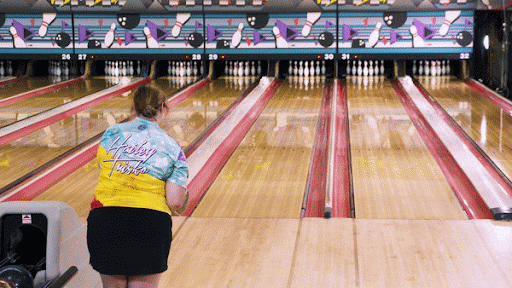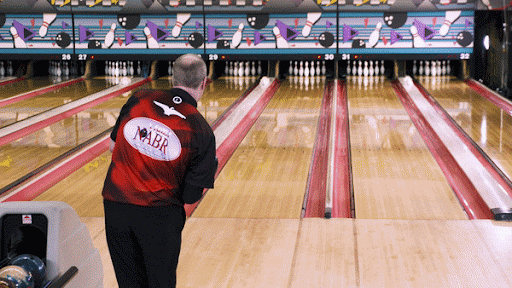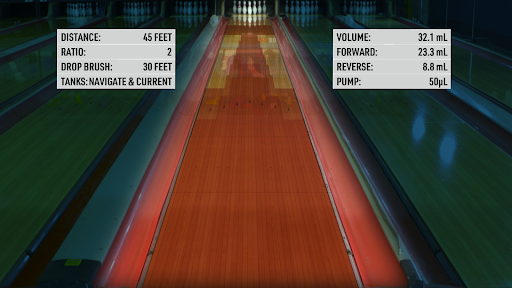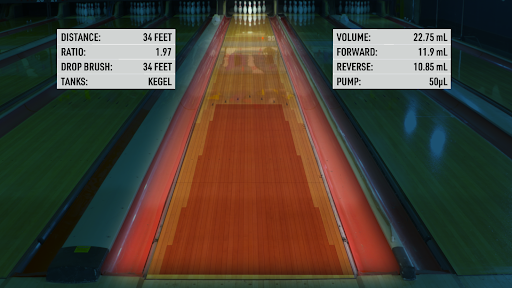In our previous article, we discussed how to alter ball speed and axis rotation. In part two of this three-part series, you’ll learn how to play different zones on the lane and the differences between oil patterns.
When working on this in your training session, the goal is to strike consistently while playing each arrow or zone.
This will be different for each player, depending on your style and the lane conditions you are bowling on.
Four Zones with Ball Changes
Each zone or arrow requires bowlers to adjust how they approach the area.
On the first arrow or zone one, Hailey Triske used a weaker bowling ball with her faster speed and normal release.

On the second arrow or zone two, Triske used her benchmark ball with her normal speed and normal release. She also moved left with her feet and eyes from the previous shot.

On the third arrow or zone three, Trikse used her benchmark ball with her slower speed and normal release. She also moved left with her feet and eyes from the previous shot.

On the fourth arrow or zone four, Triske used a weaker ball with her normal speed and she increased her axis rotation.

Four Zones with the Same Ball
On the first arrow or zone one, Pohl used his benchmark ball with his faster speed and minimum axis rotation.

On the second arrow or zone two, Pohl used his benchmark ball with his normal speed and normal release.

On the third arrow or zone three, Pohl used his benchmark ball with his slower speed and normal release.

On the fourth arrow or zone four, Pohl used his benchmark ball with his normal speed and more axis rotation.

As you can see, there are many different ways to get to the pocket. Training each of them will prepare you for success at your next competition.
When making any adjustment in bowling during competition, you should only make an adjustment if you know that you’ve fundamentally thrown a good shot.
The result may not be what you want, but you now know it’s the lane creating a problem, not you.
Hold yourself accountable and make moves off of good fundamental shots that result in undesirable ball motion and pin count.
Oil Volume and Distance
Tournament conditions generally have a ratio of 3:1, meaning that there is three times the amount of oil in the middle than the outside part of the lane.
The typical house shot is 10:1.
The big difference is the room for error. When you miss to the outside on a house shot, it will come back, and when you pull the ball, it holds, making it easier to get to the pocket.
The room for error is less on tournament conditions.
Knowing the distance of the oil pattern tells you where to play, and knowing the volume of oil tells you which bowling ball to use.
Here is how oil volume is gauged:
- Low volume of oil is between 20 mL–25 mL
- Medium volume of oil is between 23 mL–27 mL
- High volume of oil is between 25 mL–30 mL
The rule of 31 tells us to subtract 31 from the distance of the oil pattern you are bowling on, resulting in the break point.
The break point is the board at the end of the pattern (and beginning of the friction) in which the bowling ball starts to make it turn towards the headpin.
Long Patterns
The first oil pattern is 47 feet with 20mL of oil, making it a long pattern with a low volume of oil.
The breakpoint is on the 16 board located 47 feet down lane. Pohl suggests a stronger bowling ball with less surface and a weaker layout.

The second oil pattern is 45 feet with 32.1mL of oil, making it a long pattern with a higher volume of oil.
The breakpoint is on the 14 board located 45 feet down lane. Pohl suggests a stronger bowling ball with more surface.

Short Patterns
The first oil pattern is 34 feet with 22.75mL of oil, making it a short pattern with a low volume of oil.
The breakpoint is on the 3 board located 34 feet down lane. Pohl suggests a weaker bowling ball with less surface.

The second oil pattern is 33 feet with 27.995mL of oil, making it a short pattern with a higher volume of oil.
The breakpoint is on the 2 board located 33 feet down lane and Pohl suggests a stronger bowling ball with more surface and a weak layout.

Knowing how to play different zones and understanding the oil patterns distance and volume will reward you greatly on your journey to becoming more versatile in bowling.

Break Pint information gave this old man a headache but I learned from the videos and explanations.